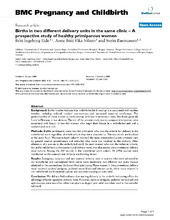| dc.contributor.author | Eide, Britt Ingeborg | en_US |
| dc.contributor.author | Nilsen, Anne Britt Vika | en_US |
| dc.contributor.author | Rasmussen, Svein | en_US |
| dc.date.accessioned | 2014-10-31T10:48:29Z | |
| dc.date.available | 2014-10-31T10:48:29Z | |
| dc.date.issued | 2009-06-22 | eng |
| dc.identifier.issn | 1471-2393 | |
| dc.identifier.uri | https://hdl.handle.net/1956/8701 | |
| dc.description.abstract | Background: Earlier studies indicate that midwife-led birth settings are associated with modest benefits, including reduced medical interventions and increased maternal satisfaction. The generalizability of these studies to birth settings with low intervention rates, like those generally found in Norway, is not obvious. The aim of the present study was to compare intervention rates associated with labour in low-risk women who begin their labour in a midwife-led unit and a conventional care unit. Methods: Eligible participants were low-risk primiparas who met the criteria for delivery in the midwife-led ward regardless of which cohort they were allocated to. The two wards are localised at the same floor. Women in both cohorts received the same standardized public antenatal care by general medical practitioners and midwifes who were not involved in the delivery. After admission of a woman to the midwife-led ward, the next woman who met the inclusion criteria, but preferred delivery at the conventional delivery ward, was allocated to the conventional delivery ward cohort. Among the 252 women in the midwife-led ward cohort, 74 (29%) women were transferred to the conventional delivery ward during labour. Results: Emergency caesarean and instrumental delivery rates in women who were admitted to the midwife-led and conventional birth wards were statistically non-different, but more women admitted to the conventional birth ward had episiotomy. More women in the conventional delivery ward received epidural analgesia, pudental nerve block and nitrous oxide, while more women in the midwife-led ward received opiates and non-pharmacological pain relief. Conclusion: We did not find evidence that starting delivery in the midwife-led setting offers the advantage of lower operative delivery rates. However, epidural analgesia, pudental nerve block and episiotomies were less often while non-pharmacological pain relief was often used in the midwifeled ward. | en_US |
| dc.language.iso | eng | eng |
| dc.publisher | BioMed Central | eng |
| dc.rights | Attribution CC BY | eng |
| dc.rights.uri | http://creativecommons.org/licenses/by/2.0 | eng |
| dc.title | Births in two different delivery units in the same clinic - A prospective study of healthy primiparous women | en_US |
| dc.type | Peer reviewed | |
| dc.type | Journal article | |
| dc.date.updated | 2013-08-28T16:45:27Z | |
| dc.description.version | publishedVersion | en_US |
| dc.rights.holder | Copyright 2009 Eide et al; licensee BioMed Central Ltd. | |
| dc.rights.holder | Britt Eide et al.; licensee BioMed Central Ltd. | |
| dc.source.articlenumber | 25 | |
| dc.identifier.doi | https://doi.org/10.1186/1471-2393-9-25 | |
| dc.identifier.cristin | 343590 | |
| dc.source.journal | BMC Pregnancy and Childbirth | |
| dc.source.40 | 9 | |

